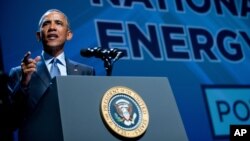U.S. President Barack Obama has announced new executive actions and other efforts aimed at making it easier for homeowners and businesses to invest in green energy improvements that in the past may have been impractical or unaffordable.
Obama was the keynote speaker at a clean energy conference in the southwestern city of Las Vegas, Nevada Monday night. He noted that some fossil fuel and utility interests are fighting the nation's rush to cleaner, cheaper and more efficient energy. But he said, "Sorry, we're moving forward."
The president said that after decades of being told renewable energy doesn't make economic sense, "today that's no longer true."
Among the steps announced by the president are new rules from the Federal Housing Administration that could significantly expand the use of so-called PACE (Property Assessed Clean Energy) loans that allow homeowners to install energy improvements and pay back their costs over time. To date, use of that financing has been constrained by regulatory obstacles. He also said the Department of Energy will make $1 billion in additional loan guarantees available to encourage innovation in technologies that give Americans more flexibility in choosing renewable energy options.
Obama's speech, at an annual energy conference hosted by Senate Democratic leader Harry Reid, was aimed at countering fossil fuel and utility interests that have been working to undercut clean energy policies with arguments that the matter should be left to the free market.
The president had returned from a two-week vacation Sunday with a number of important issues facing him over the next few months, including working to push the international agreement on Iran's nuclear program through a skeptical Congress.
But with the world trying to clinch a binding agreement to address climate change by the end of the year, he has been working on reforms at home to cut carbon emissions, while also cutting costs for U.S. consumers.
Modernization of power grid
Monday's National Clean Energy Summit was aimed at looking to ways governments and the private sector can work together on clean energy solutions and modernizing the U.S. power grid, according to organizers. In addition to Obama, speakers included leaders from electric utility companies, solar technology firms and an electric car maker.
Earlier this month, Obama unveiled new regulations for power plants with a goal of cutting polluting carbon dioxide emissions by 32 percent below 2005 levels by the year 2030. The plan, if implemented, also would call for boosting the amount of power generated by renewable sources so that it makes up 28 percent of overall power production.
Power companies already have been converting some of their operations in recent years, increasing their reliance on natural gas, solar and wind. As a result, government data has shown a drop in carbon emissions from coal-burning power plants.
The issue of reducing the amount of carbon released into the atmosphere is a major focus on global efforts to contain a rise in temperatures.
The U.S. National Oceanographic and Atmospheric Administration issued a report last week citing July as the warmest month ever recorded worldwide since data collection began in 1880. The same report said that so far 2015 is the warmest year on record.
Delegations from all over the world will convene in Paris on November 30 for nearly two weeks of talks to decide how to reach the goal of keeping temperatures from rising more than 2 degrees Celsius above pre-industrial levels, which scientists warn would bring extreme weather and rising seas. They want a binding agreement with specific plans for each country to accomplish.
A new agreement would go into effect in 2020.











